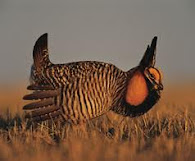via newsok.com
August 5, 2009
LUBBOCK, Texas — A little prairie chicken could give the wind energy industry big fits in Texas, Oklahoma and three other states.
Should the lesser prairie chicken become listed as threatened or endangered — and it’s close now — there would be significant restrictions on companies hoping to plant towering turbines across a five-state region believed to have some of the nation’s best wind energy potential.
"We’ve never seen the likes of this,” said Texas Parks and Wildlife Department wildlife biologist Heather Whitlaw, who is part of conservation efforts with the other states and believes the bird could be listed within two years. "Anybody who puts anything on our landscape would be evaluated in one form or another.”
Scientists believe the prairie chicken population has dropped 80 percent nationally since 1963, the result of habitat loss and fragmentation, population isolation, drought and changes in land usage.

They once numbered about 3 million across an area that stretches through eastern New Mexico, eastern Colorado, western Kansas, northwest Oklahoma, and in parts of the Texas Panhandle and South Plains. Estimates show their population now at about 30,000.
The birds’ habitat could shrink further beginning in September when 1.3 million acres in the five-state area come out of a federal land conservation program started about 25 years ago. Farmers and ranchers may then use the land as they wish — which could include crop cultivation that would eliminate more of the bird’s breeding and nesting grounds.
Their habitats also lie in areas with plentiful and strong wind resources — where energy companies are eager to build.
The companies, which have been criticized before over the number of birds and bats killed by flying into the blades of wind turbines, are being more careful about where they put wind farms, said Laurie Jodziewicz, a spokeswoman for the American Wind Energy Association.
For the lesser prairie chicken, it’s not about the blades — it’s about size.
The shortflight bird, which weighs about 400 grams, has an aversion to tall structures around its breeding and nesting grounds because its predators include raptors who perch in high places awaiting their opportunity.
For about five years the wind industry generally has not heeded a 2004 recommendation from the U.S. Fish and Wildlife Service asking companies not to put turbines within 5 miles of a lek, the lesser prairie chickens’ breeding grounds. The American Wind Energy Association has asked for the scientific basis of the 5-mile limit.
"We still have not seen anything that looked at prairie grouse and leks and wind turbines,” Jodziewicz said. "I don’t know that (any wind company) is” looking at the 5-mile limit.
The lesser prairie chicken should have been listed as threatened or endangered 10 years ago, said Mark Salvo with the Sante Fe, N.M.-based group WildEarth Guardians, which filed a listing petition for it in the mid-1990s.
Restoring the prairie chicken population "will be much more difficult now” even if it is listed, he said. Moreover, as developers "slice and dice the habitat into ever smaller spaces,” Salvo said, other plants and animals that depend on that kind of habitat also will suffer.
"It’s already a relatively small landscape and it’s getting smaller,” he said. "We are in an emergency situation here.”





No comments:
Post a Comment